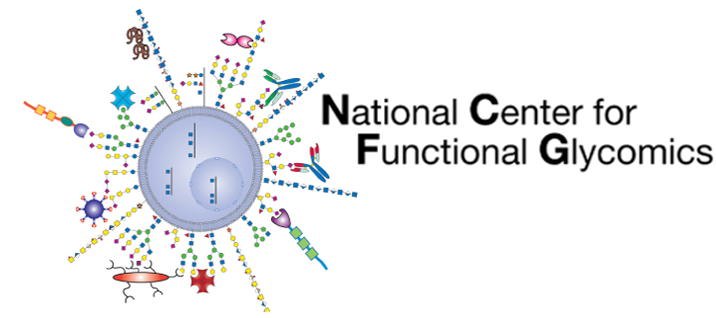The “National Center for Functional Glycomics” (NCFG) as a Biomedical Technology Research Center (BTRC) is devoted to the technology of glycan recognition through microarray display and other modes of glycan presentation. This Center is the first of its kind with the central focus being exploration of the functional glycome of cells through technologies to define glycan recognition by glycan-binding proteins (GBPs). There is tremendous synergy between our research/technology development and the unmet needs of the research community. The Center is an outgrowth of the highly successful Consortium for Functional Glycomics (CFG) and the development within the CFG of glycan microarray technologies as a key resource. The Center will address an unmet need in the research community by helping to foster technology development in the area of functional glycomics and array technologies, enhance biomedical research, enlarge collaborations in the field, and provide needed services, training, and data and technology dissemination.
A major technical breakthrough in glycosciences to facilitate “decoding” of glycan functions and recognition was the development of printed defined glycan microarrays, in which picograms of defined glycans are captured on a solid surface and interrogated by a GBP, cell, or organism (e.g. virus or bacteria. This evolved from the first technology that was primarily an ELISA-type format, in which biotinylated glycans were captured in 96-well streptavidin-coated plates and interrogated with fluorescent-based GBPs or anti-GBP reagents. This ELISA-type technology required high amounts of glycans and GBPs, and was impractical as the library of glycans grew. It was superseded in 2004 by the development of printed defined glycan microarray, led by the pioneering efforts of the CFG. Although at the time there were contemporaneous technology developments in printed microarray technology, the CFG became the leader in the field, due to the diversity of glycans and their public availability, the extremely low background and high reproducibility of the glycan microarray, as well as linkage to emerging public-accessible databases. The Glycomics Center at Emory University School of Medicine housed the Protein-Glycan Interaction Core (Core H) of the CFG from 2006 through 2011, then extended via a Legacy Resource Grant through 2014, where glycan microarray analyses were conducted using version 5.1 of the printed glycan microarray that contained 610 individual glycans. This is the only glycan microarray generally available to the public with an associated public database. In 2014 the arrays became a fee-for-service component due to ending of the Legacy grant funding and has now moved to Beth Israel Deaconess Medical Center in Boston, MA where the fee-for-service glycan arrays will continue under the direction of Dr. Richard Cummings and the NCFG.
The utilization of the CFG’s defined glycan microarray has helped to revolutionize the study of protein-glycan interactions, and the defined glycan microarray has become the benchmark in determining the specificity of GBPs and viruses. Expansion and continuation of access to this technology is a fundamental technology and service aspect of the NCFG.
The major technological theme of the NCFG is to explore glycan recognition by GBPs using glycan display technologies, including glycan microarray, glycopeptides and other glycoconjugates, and microsphere technology. Because of the continued demand of glycan microarray analyses, and in a broader sense because of the vast involvement of glycan recognition and structure in so many aspects of health and disease, new technologies need to be developed and adapted to address the exciting frontiers of glycomics and glycobiology. The biomedical research community is energized to access available technologies. Thus, we anticipate future needs, accessibility, and developments of glycan production and derivatization to move the field forward. We view these frontiers as coming together in what we broadly term “Functional Glycomics”, and based on our enormous number of collaborative interactions, we are uniquely poised to provide training and disseminate information about technologies and advances in the field of functional glycomics. Thus, the NCFG is devoted to the technology of glycan recognition through microarray display and other modes of glycan presentation. It is through the NCFG that the glycan microarray technologies and associated innovations, driven by needs of collaborators requiring novel solutions to questions involving glycan structure and function, will be made available to the biomedical community.
